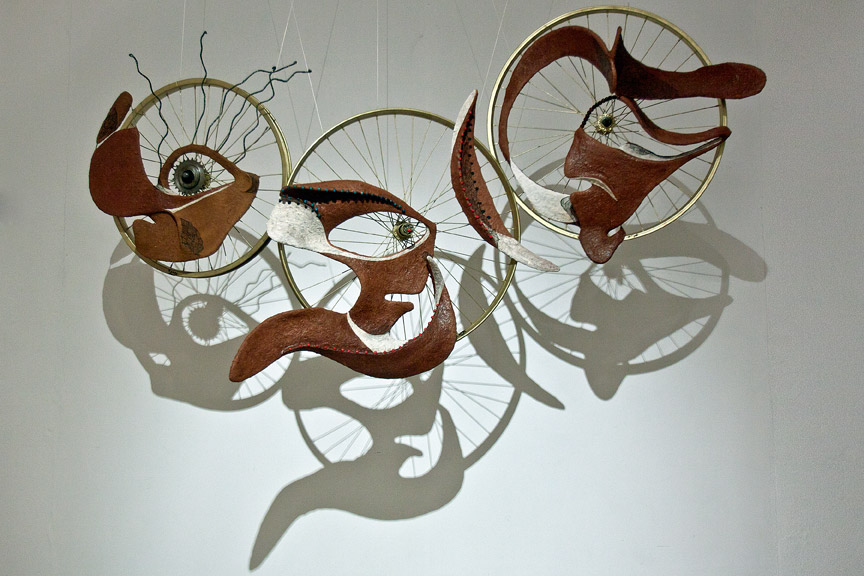Shows
Meena Kayastha’s “Lyrics from the Junkyard”


Nepali sculptor Meena Kayastha’s debut solo show at Siddhartha Gallery presents an abundance of biomorphic forms and rich ideas, featuring 25 small- to medium-sized sculptures spread over all three floors of the space. Kayastha’s mixed-media works are made primarily out of papier-mâché, terracotta and other materials gleaned from junkyards. Although her extensive body of work was developed over the past seven years, all the works emerge from the same overarching themes of love, motherhood, ancestry, life and chaos.
Choosing materials that “spoke” to her, Kayastha explains her use of discarded rubbish saying: “I fear aging. Nature says it can’t let me immortalize myself, but I could however eternalize my feelings and my thoughts. That’s why I chose junk. I saw forms and I brought those out, I heard music and I got them singing, it was junk once and I stopped it aging. I have put in all my emotions to breathe new life into junk.” Like Duchamp, the Kayastha incorporates found materials and trash not only aesthetically but also conceptually.
Although an emerging artist who has never lived outside of Nepal, Kayatha cites Picasso, Brancusi, the Surrealists and Duchamp as points of inspiration, as well as various indigenous cultures. This reveals her awareness of global art and anthropology. One cannot help but draw a parallel between Kayastha’s interest in indigenous art and the influence that African tribal art has had on many of the modernist artists that inspire her, as reflected in most of the pieces in “Lyrics from the Junkyard.” For instance, the black ink pattern drawn on some Kayastha’s sculptures—comprising numerous intricately grouped polygons each filled with parallel lines—is inspired by North American Puebloan pottery.
While global art practices inform the artist’s style, heritage and culture remain the focal points of consideration in works such as Lyrics of Life (2010). Here Kayastha transforms two frying pans, hanging side-by-side on one wall, to evoke human faces by applying a mixture of encaustic and pigment to add color and texture to the cooking-wares. One of the figures sports a traditional Nepali nose ring that many women wear, while cowrie shells, used as playing pieces in various Nepali games, are embedded as eyes. Although not cited as influences by the artist, the slightly garish, simplistic human faces and Kayastha’s emphasis on texture and materiality evoke Art Brut or depictions of the human face in paintings by George Dubuffet, such as Fleshy Face with Chestnut Hair (1951).
Kayastha created many of the sculptures by candlelight during Nepal’s ubiquitous blackouts, which may explain her thoughtful interest in shadow, an important element in Lyrics of Chaos (2011). A trio of tyre-less bicycle wheels are suspended from the ceiling with fishing line; fastened to each are Surrealist papier-mâché shapes, embellished with the Puebloan pattern and traditional Nepali black, turquoise and red beads. Amidst all the busyness, the eye is instinctively drawn to the interplay of shadows cast by these sculptures onto the wall behind them, as they sway and overlap in response to subtle air movements.
Lyrics of Ancestors (2011) consists of a set of five wall sculptures made from scrap metal, spare parts and papier-mâché. A hybrid of elegant, elongated, yet nonetheless vaguely human and animal shapes, this set of sculptures appears to be a three-dimensional incarnation of the forms found in organic abstraction, such as paintings by Arshile Gorky and Joan Miró, which intimate primordial beginnings, and perhaps a broader notion of ancestry.
Although Nepal is considered a hotspot for international tourism, the country remains generally poor and presently lacks the resources to set up a world-class contemporary arts infrastructure unlike, say, neighboring India. It should be noted, however, that 2012 will bring the promising second edition of the Kathmandu International Arts Festival, established by Siddhartha Gallery in 2009. Nevertheless, in Nepal, where contemporary artists are scarce, and sculptors even more so, Kayastha remains a true pioneer.







